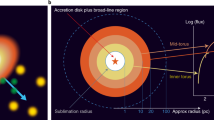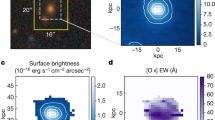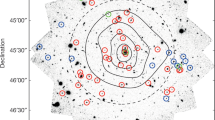Abstract
Although it is widely accepted that most galaxies have supermassive black holes at their centres1,2,3, concrete proof has proved elusive. Sagittarius A* (Sgr A*)4, an extremely compact radio source at the centre of our Galaxy, is the best candidate for proof5,6,7, because it is the closest. Previous very-long-baseline interferometry observations (at 7 mm wavelength) reported that Sgr A* is ∼2 astronomical units (au) in size8, but this is still larger than the ‘shadow’ (a remarkably dim inner region encircled by a bright ring) that should arise from general relativistic effects near the event horizon of the black hole9. Moreover, the measured size is wavelength dependent10. Here we report a radio image of Sgr A* at a wavelength of 3.5 mm, demonstrating that its size is ∼1 au. When combined with the lower limit on its mass11, the lower limit on the mass density is 6.5 × 1021M⊙ pc-3 (where M⊙ is the solar mass), which provides strong evidence that Sgr A* is a supermassive black hole. The power-law relationship between wavelength and intrinsic size (size∝wavelength1.09) explicitly rules out explanations other than those emission models with stratified structure, which predict a smaller emitting region observed at a shorter radio wavelength.
This is a preview of subscription content, access via your institution
Access options
Subscribe to this journal
Receive 51 print issues and online access
$199.00 per year
only $3.90 per issue
Buy this article
- Purchase on Springer Link
- Instant access to full article PDF
Prices may be subject to local taxes which are calculated during checkout


Similar content being viewed by others
References
Begelman, M. C. Evidence for black holes. Science 300, 1898–1903 (2003)
Kormendy, J. & Richstone, D. Inward bound–The search for supermassive black holes in galactic nuclei. Annu. Rev. Astron. Astrophys. 33, 581—624 (1995)
Rees, M. J. Black hole models for active galactic nuclei. Annu. Rev. Astron. Astrophys. 22, 471–506 (1984)
Balick, B. & Brown, R. L. Intense sub-arcsecond structure in the Galactic Center. Astrophys. J. 194, 265–270 (1974)
Melia, F. & Falcke, H. The supermassive black hole at the Galactic Center. Annu. Rev. Astron. Astrophys. 39, 309–352 (2001)
Schödel, R. et al. A star in a 15.2 year orbit around the supermassive black hole at the centre of the Milky Way. Nature 419, 694–696 (2002)
Ghez, A. M. et al. Stellar orbits around the Galactic Center black hole. Astrophys. J. 620, 744–757 (2005)
Bower, G. C. et al. Detection of the intrinsic size of Sagittarius A* through closure amplitude imaging. Science 304, 704–708 (2004)
Falcke, H., Melia, F. & Agol, E. Viewing the shadow of the black hole at the Galactic Center. Astrophys. J. 528, L13–L16 (2000)
Shen, Z.-Q. & Lo, K. Y. High-resolution 86 GHz VLBA imaging of Sgr A*. Prog. Theor. Phys. Suppl. 155, 413–414 (2004)
Reid, M. et al. The position, motion, and mass of Sgr A*. Astron. Nachr. 324 (Suppl. Iss. 1), 505–511 (2003)
Davies, R. D., Walsh, D. & Booth, R. S. The radio source at the Galactic nucleus. Mon. Not. R. Astron. Soc. 177, 319–333 (1976)
Lo, K. Y. et al. On the size of the galactic centre compact radio source: diameter <20 AU. Nature 315, 124–126 (1985)
Alberdi, A. et al. VLBA Image of Sgr A* at λ = 1.35 cm. Astron. Astrophys. 277, L1–L4 (1993)
Bower, G. C. & Backer, D. C. 7 Millimeter VLBA observations of Sagittarius A*. Astrophys. J. 496, L97–100 (1998)
Lo, K. Y., Shen, Z.-Q., Zhao, J.-H. & Ho, P. T. P. Intrinsic size of Sagittarius A*: 72 Schwarzschild radii. Astrophys. J. 508, L61–L64 (1998)
Shen, Z.-Q., Liang, M. C., Lo, K. Y. & Miyoshi, M. Searching for structural variability in Sgr A*. Astron. Nachr. 324 (Suppl. Iss. 1), 383–389 (2003)
Doeleman, S. S. et al. Structure of Sagittarius A* at 86 GHz using VLBI closure quantities. Astron. J. 121, 2610–2617 (2001)
Miyoshi, M. et al. Evidence for a black hole from high rotation velocities in a sub-parsec region of NGC4258. Nature 373, 127–129 (1995)
Maoz, E. Dynamical constraints on alternatives to supermassive black holes in galactic nuclei. Astrophys. J. 494, L181–L184 (1998)
Torres, D. F., Capozziello, S. & Lambiase, G. Supermassive boson star at the galactic center? Phys. Rev. D 62, 104012 (2000)
Gwinn, C. R., Danen, R. M., Tran, T. Kh., Middleditch, J. & Ozernoy, L. M. The Galactic center radio source shines below the Compton limit. Astrophys. J. 381, L43–L46 (1991)
Genzel, R. et al. Near-infrared flares from accreting gas around the supermassive black hole at the Galactic Centre. Nature 425, 934–937 (2003)
Falcke, H. et al. The simultaneous spectrum of Sagittarius A* from 20 centimeter to 1 millimeter and the nature of the millimeter excess. Astrophys. J. 499, 731–734 (1998)
Melia, F. An accretion black hole model for Sagittarius A*. II. A detailed study. Astrophys. J. 426, 577–585 (1994)
Königl, A. Relativistic jets as X-ray and gamma-ray sources. Astrophys. J. 243, 700–709 (1981)
Falcke, H. & Markoff, S. The jet model for Sgr A*: Radio and X-ray spectrum. Astron. Astrophys. 362, 113–118 (2000)
Yuan, F., Quataert, E. & Narayan, R. Nonthermal electrons in radiatively inefficient accretion flow models of Sagittarius A*. Astrophys. J. 598, 301–312 (2003)
Özel, F., Psaltis, D. & Narayan, R. Hybrid thermal-nonthermal synchrotron emission from hot accretion flows. Astrophys. J. 541, 234–249 (2000)
Acknowledgements
The Very Large Array and the Very Long Baseline Array are operated by the National Radio Astronomy Observatory, which is a facility of the National Science Foundation, operated under cooperative agreement by Associated Universities Inc. Z.-Q.S. acknowledges support from the One-Hundred-Talent programme of the Chinese Academy of Sciences
Author information
Authors and Affiliations
Corresponding author
Ethics declarations
Competing interests
Reprints and permissions information is available at npg.nature.com/reprintsandpermissions. The authors declare no competing financial interests.
Supplementary information
Supplementary Notes
A description of the model fitting procedure used to determine apparent structure of Sgr A* quantatively, and the revision of the wavelength-dependent scattering law. (DOC 138 kb)
Supplementary Figure
Measured (FWHM) angular size of Sgr A* vs. observing wavelength. (PDF 27 kb)
Rights and permissions
About this article
Cite this article
Shen, ZQ., Lo, K., Liang, MC. et al. A size of ∼1 au for the radio source Sgr A* at the centre of the Milky Way. Nature 438, 62–64 (2005). https://doi.org/10.1038/nature04205
Received:
Accepted:
Issue Date:
DOI: https://doi.org/10.1038/nature04205
This article is cited by
-
Black holes up close
Nature (2023)
-
Testing general relativity with the Event Horizon Telescope
General Relativity and Gravitation (2019)
-
Observing supermassive black holes in virtual reality
Computational Astrophysics and Cosmology (2018)
-
The Milky Way’s Supermassive Black Hole: How Good a Case Is It?
Foundations of Physics (2017)
-
Possible Alternatives to the Supermassive Black Hole at the Galactic Center
Journal of Astrophysics and Astronomy (2015)
Comments
By submitting a comment you agree to abide by our Terms and Community Guidelines. If you find something abusive or that does not comply with our terms or guidelines please flag it as inappropriate.



